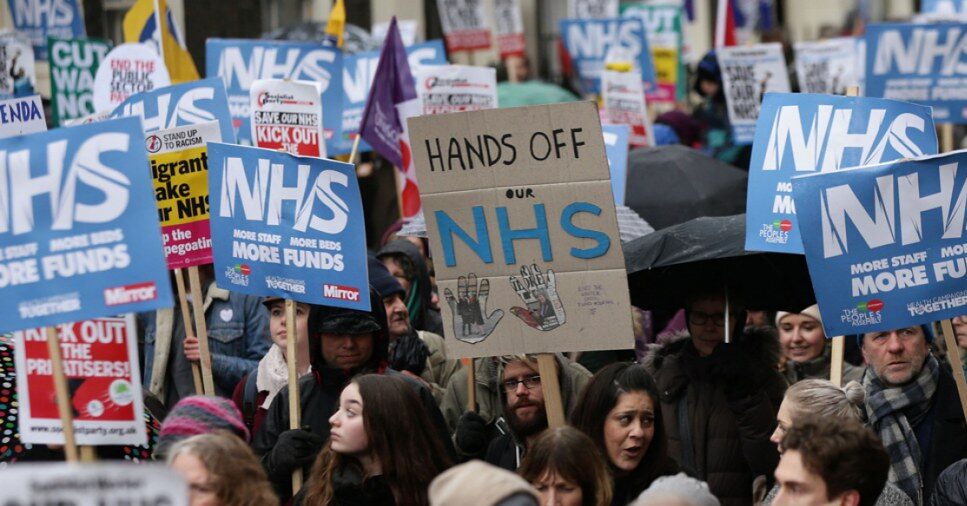

By Andy Yorke
WINTER IS here and along with it the deepest NHS crisis yet. Despite the respite from covid in 2022, waiting lists hit an all-time record of 7.2 million in December, with up to 500 excess deaths a week as a result of delays.
A record number of patients waited over 12 hours for A&E treatment. So there was widespread incredulity as the Sunak government spokesperson denied this ‘unprecedented challenge’ was a crisis, claiming ‘we are confident we are providing the NHS with the funding it needs’ and trying to pin the crisis on the pandemic.
But this crisis began long before the pandemic hit. The 6% annual growth of the NHS spending under the last Labour government was slashed to less than 1.8% with austerity. The UK fell way below the international average for beds per capita, even compared to poorer countries, with permanently unsafe bed occupation rates since 2010. The 18-week treatment target hasn’t been met since 2016.
In the 2017 winter crisis, the NHS was forced to cancel tens of thousands of operations. Even before the pandemic hit, 8,270 A&E patients waited more than 12 hours for treatment in 2019 (a sixfold increase on 2015). In 2022 the figure approached 350,000, almost a thousand a day! The NHS crisis is compounded by the crisis in the underfunded, overwhelmingly private social care sector.
Breaking the NHS
The key to the crisis is funding and staff. Medical staff vacancies and waiting lists have risen together. Every Tory government produces another painful reorganisation, yet despite calls from unions and the BMA for transparent workforce assessments, no government has produced a national NHS workforce strategy since 2003. The Tories instead rely on “stopgaps” i.e. the private sector, from agencies to hospitals.
46,000 nurse vacancies (11.7% of the workforce) demonstrates the link between Tory underfunding and privatisation. Now, in a vicious circle, thousands of nurses are leaving the NHS due to overwork, stress and falling pay. The nurses’ strike is a first step toward reversing this Tory-made disaster.
The Sunak government, like all its Tory predecessors, is using the crisis to push privatisation further. The government is blanking talks with the health unions and continuing the covid policy of paying the private hospitals and care homes for beds, costing the NHS up to £1 billion.
For the Tories, hospitals are a massive block to further privatisation, so plans for 150 mental health hubs to divert patients away from A&E are part of transferring care into the community and the long-term fragmentation of the NHS.
The Tories won’t fund more nurses but are happy to repeatedly reorganise the NHS to squeeze out more profit. The latest reorganisation established 42 integrated care boards covering NHS England. These are part of the Tory drive to fragment the NHS and boost access for private companies at every level, including commissioning and planning.
Meanwhile half a million people took out private health insurance in 2022, and many more paid to go private for their treatment, effectively jumping the NHS queue and getting a scan or operation from the same doctor, in the same hospital, that they had been told wouldn’t be available for months!
Will Labour save the NHS?
Many put their hopes in Labour. But the New Labour government combined increased funding with cuts to beds and staffing levels, and further opening the NHS up to privatisation. Keir Starmer pledges his government would hike funding but that ‘investment alone won’t be enough’—code for yet more reorganisation and a bigger role for the private sector.
In reality, restoring the 45p top tax rate won’t come close to filling the black hole in NHS funding, and there is no plan to reverse the damage of four decades of marketisation and privatisation. Worse, the shadow health secretary’s solution is to use the private sector to get waiting lists down.
A victorious nurses strike requires not just staying firm on a fully-funded real-terms pay rise, but depends on launching a mass movement to defend the NHS and fight for a fully public service, funded by taxing the rich. This is the surest way to ensuring the NHS workforce and users are in a position to make Labour really defend the NHS.